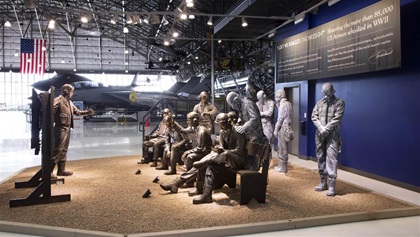‘Lest we forget’
The last man standing remembers his peers

Lest we forget: the mission is the 20-by-20-foot bronze installation artist Fredric Arnold (above) created to honor his fallen comrades from his service as a pilot in World War II. It has been on display at the Wings Over the Rockies Air and Space Museum in Denver.
Photography by Jafe Parsons
Arnold had held the memory of those other young men deep in his heart. He remembered their youthful faces and enthusiasm as they were thrust time and again into combat, often to not return. An artist from his youth, Arnold would have a rich and varied life as a commercial artist, an author, an actor, an inventor, and a successful businessman. His son, Marc, says he believes his father lived the lives of the 12 men who didn’t. And so, when the call came from Hagenback—and at the age of 87 after trying to think of ways to honor his friends—the surviving soldier turned back to his first love and began first a mural and then finally a sculpture to honor those “Lest We Forget.”
The 20-by-20-foot cast bronze sculpture features 12 life-size sculptures of soldiers attending a pre-combat briefing. Of the 12 men, five are in ghostly relief, symbolizing those already killed in action. “My father wanted to show the human cost of war,” his son said. “It was his goal to tell the story, and I think no other artist could have—it had to be someone who had been there.”
 The finished sculpture was originally planned for the National World War II Museum in New Orleans, Louisiana, but the museum was not ready for it when the sculpture was complete in 2016. Marc Arnold thinks this was a last gift to his father—the sculpture was temporarily installed at the Wings Over the Rockies Air and Space Museum in Denver, near where his father lived. “Dad had two years to visit and talk to the public. Finishing it was the fulfillment of his vow.” Fredric Arnold died at age 96 on Memorial Day 2018. “It was his passion for seven years and he never stopped thinking about it. He declined after he finished it,” his son said.
The finished sculpture was originally planned for the National World War II Museum in New Orleans, Louisiana, but the museum was not ready for it when the sculpture was complete in 2016. Marc Arnold thinks this was a last gift to his father—the sculpture was temporarily installed at the Wings Over the Rockies Air and Space Museum in Denver, near where his father lived. “Dad had two years to visit and talk to the public. Finishing it was the fulfillment of his vow.” Fredric Arnold died at age 96 on Memorial Day 2018. “It was his passion for seven years and he never stopped thinking about it. He declined after he finished it,” his son said.
Now the World War II Museum is ready for its centerpiece—“Lest We Forget: The Mission” will have a place of honor outside and in front of the museum in New Orleans. It will be delivered sometime this fall. Donations are being sought to undertake another casting, so the sculpture can be shown in other museums—especially Wings Over the Rockies, where it began.
Web: www.lestweforgetsculpture.org
Email [email protected]
LITTLE-KNOWN AVIATION HISTORY
‘Conceived by genius’
November 19, 1932
The monument commemorating the Wright brothers’ first flight is dedicated in Kill Devil Hills, North Carolina. The 60-foot gray granite monument was erected on Big Kill Devil Hill, which was groomed to have the monument stand atop its 90-foot peak. It is the largest monument dedicated to a (then) living person. Orville attended the dedication ceremonies on November 19, 1932, although he declined to speak; it was reported he’d have preferred the monument not be made for another 50 years. Wilbur had died in 1912. Designed by a New York architectural firm chosen out of 36 entries, more than 1,200 tons of granite from Mt. Airy, North Carolina, was brought in on barges. The monument cost $285,000. Its star-shaped base is the same shape as the base of the Statue of Liberty; six panels depict aviation-related images such as Icarus, a rising Phoenix, kites, and an homage to Otto Lilienthal; and most visitors like to place their children in front of the word “Genius” for photos. It’s part of this quote on the monument: “In commemoration of the conquest of the air by the brothers Wilbur and Orville Wright—conceived by genius—achieved by dauntless resolution and unconquerable faith.”


